China Lands Probe On The Far Side Of The Moon
China has landed a probe on the far side of the Moon, the latest step forward in an aggressive Chinese push into space.
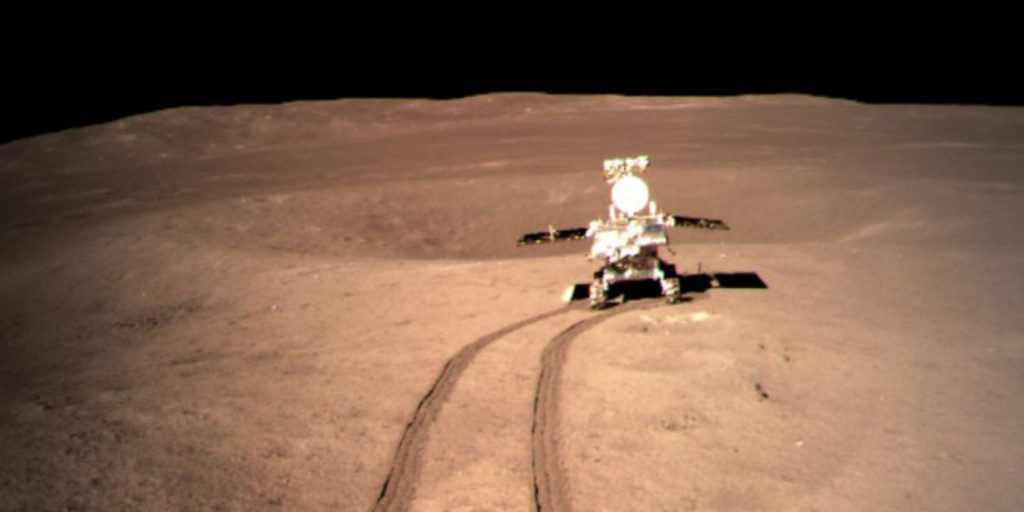
China hasn’t accomplished as much in space as the United States and Russia, but it has managed to land a probe somewhere that neither nation has ever been:
BEIJING — China reached a milestone in space exploration on Thursday, landing a vehicle on the far side of the moon for the first time in history, the country’s space agency announced.
The landing of the probe, called Chang’e-4 after the moon goddess in Chinese mythology, is one in a coming series of missions that underscore the country’s ambitions to join — and even lead — the space race.
China landed another rover on the moon in 2013, joining the United States and the Soviet Union as the only nations to have carried out a “soft landing” there, but the Chang’e-4 is the first to touch down on the side of the moon that perpetually faces away from the Earth.
The mission “has opened a new chapter in humanity’s exploration of the moon,” the China National Space Administration said in an announcement on its website. The agency said the spacecraft landed at 10:26 a.m. Beijing time at its target on the far side of the moon.
The probe sent back to the earth the first close-up image of the moon’s far side using a relay satellite China calls “Queqiao,” or “Magpie Bridge,” the space agency said in a notice that included images it said were taken by the probe.
Although a latecomer by decades to space exploration, China is quickly catching up, experts say, and could challenge the United States for supremacy in artificial intelligence, quantum computing and other fields.
“This space mission shows that China has reached the advanced world-class level in deep space exploration,” said Zhu Menghua, a professor at the Macau University of Science and Technology who has worked closely with the Chinese space agency. “We Chinese people have done something that the Americans have not dared try.”
China now plans to begin fully operating its third space station by 2022, to put astronauts in a lunar base by later in that decade, and to send probes to Mars, including ones that could return samples of the Martian surface back to Earth.
Though the moon is hardly untrodden ground after decades of exploration, a new landing is far more than just a propaganda coup, experts say.
The crater where the Chinese landed is the oldest and deepest on the moon, so the probe’s discoveries may offer insights into the moon’s origins and evolution. And some scientists suspect that the surrounding basin may be rich in minerals. If exploiting the moon’s resources is the next step in space development, a successful mission could leave the Chinese better positioned.
“This is a major achievement technically and symbolically,” said Namrata Goswami, an independent analyst who wrote about space for the Defense Department’s Minerva Research Institute. “China views this landing as just a steppingstone, as it also views its future manned lunar landing, since its long-term goal is to colonize the moon and use it as a vast supply of energy.”
The place the probe is exploring, Dr. Goswami said, could become a future refueling base for missions deeper into space in the way “navies viewed coaling stations, for purposes of refueling and resupply.”
The Chang’e-4 was launched from Xichang, in southwestern China, early on the morning of Dec. 8 (still midday Dec. 7 in the United States), and it glided into a final, lower orbit around the moon on Sunday, 22 days later.
It landed in the Von Kármán, a flat feature about 110 miles wide that sits inside a larger basin near the moon’s south pole. The main lander will release a 300-pound rover that, barring mishap, will roam the crater. (The rover’s name, the subject of a public contest and vote, has not yet been revealed.)
The instruments aboard the lander and the rover include cameras, ground-penetrating radar and spectrometers to help identify the composition of the area, which was formed by a meteorite. Scientists hope the rocks and dirt in the area will add to the understanding of the moon’s geology.
The lander will also conduct a biology experiment to see if plant seeds will germinate and silkworm eggs will hatch in the moon’s low gravity.
CNN has more on the mission:
As you read this, a spindly-looking silver robot with a satellite dish for a head is exploring places never seen up close before by humans.
Named after the pet rabbit belonging to the mythical Chinese lunar goddess Chang’e, the Yutu 2 rover is making history as it sends back images and other data from the far side of the moon.
The rover touched down Thursday, delivered to the moon by the Chang’e 4 probe, a historical first for humankind — the far side of the moon has not previously been visited — and a major achievement for China’s increasingly impressive space program.
Thursday’s landing is the first time humanity has landed anything on Earth’s natural satellite since 2013. Its success “opened a new chapter in humanity’s exploration of the moon,” China’s National Space Administration said in a statement.
The front page of Friday’s China Daily, a state-run newspaper, featured a large photo of scientists at the Beijing Aerospace Control Center reacting to the touchdown, alongside one of the first images sent back by Chang’e 4 of the moon’s far side.
Reacting on Twitter, NASA administrator Jim Bridenstine called it a “first for humanity and an impressive accomplishment!”
China was late to the space race — it didn’t send its first satellite into orbit until 1970, by which time the US had already landed an astronaut on the moon — but it has been catching up fast.Since 2003, China has sent six crews into space and launched two space labs into Earth’s orbit. In 2013, it successfully landed a rover — Yutu 1 — on the moon, becoming only the third country to do so.
While the reaction to Thursday’s landing in China — where economic concerns are becoming increasingly pressing amid an ongoing trade war with the US — was more limited than for the previous lunar mission, the success of Chang’e 4, and the global acclaim it has brought, will be a significant boost to the Chinese space program.
That program will need all the support it can get in coming years as it attempts to realize ambitions that are, appropriately, stratospheric.
Speaking to astronauts aboard the Shenzhou 10 spacecraft by video link in 2013, Chinese President Xi Jinping said ”the space dream is part of the dream to make China stronger.”
“The Chinese people will take bigger strides to explore further into the space,” he added.
Under Xi’s leadership, China has invested billions in building up its space program, even as it asserted its influence back on Earth more aggressively and pursued the “great rejuvenation of the Chinese nation.”
The first stage of China’s space dream largely takes place in our planetary neighborhood.
In 2020, the next lunar mission, Chang’e 5, is due to land on the moon, collect samples and return to Earth, while preliminary plans are underway for a manned lunar mission in the 2030s. If successful, China would become only the second country, after the US, to put a citizen on the moon.
Beijing is also spending big on the Tiangong program, a precursor to a permanent space station it plans to launch either this year or next.
The Tiangong 2 space lab has been in orbit for over two years, and is due to return to Earth in a controlled destruction in July 2019.
“Our overall goal is that, by around 2030, China will be among the major space powers of the world,” Wu Yanhua, deputy chief of the National Space Administration, said in 2016.
Although commonly referred to as the “dark side” of the Moon, the far side of Earth’s only natural satellite actually receives as much sunlight as the side we are used to seeing from Earth. The only difference is that because the Moon is tidally locked to Earth, we only ever see one side of it. The other side has only been seen, and briefly photographed, by American astronauts who orbited the Moon during the Apollo program. Those who were alive for any of those missions will probably remember that when the vehicle was over that side of the Moon communication was not possible due to the fact that radio signals could not reach Earth, or the spacecraft, while it was on that side of the Moon. For this mission, the Chinese appear to have solved that problem by using relay satellites in orbit around the Moon that allows the craft on the lunar surface to continue to communicate with Earth and allows China’s version of Mission Control to communicate with the probe.
In any case, this is yet the latest sign that the Chinese are serious about their space program and they are well on their way to becoming as much of a player as the United States and Russia. Indeed, with the United States currently without a way to get men into orbit without the assistance of the Russians, and the International Space Station apparently on its way to being decommissioned in the not too distant future it’s not clear that either the United States or Russia is at all clear about the future direction of their respective programs, with the exception of American plans to return to the Moon sometime in the 2020s and a mission to Mars in the 2030s. Unfortunately, with all the delays that NASA’s program has seen those dates are likely to prove to be overly ambitious.
So, congratulations to China for going where no man or robot has gone before.

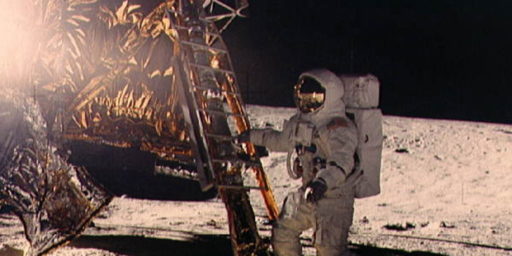
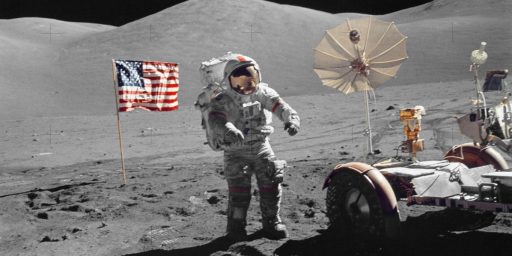
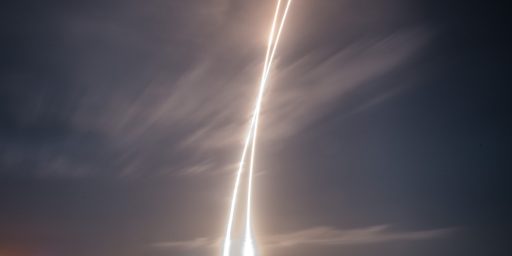

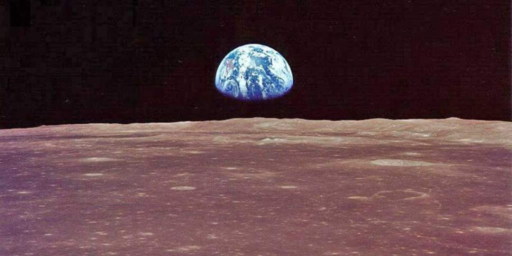
Not quite.
Before the Apollo landings, NASA sent several probes to orbit the Moon, in order to survey it for landing sites. The probes also mapped the far side. In addition the Lunar Reconnaissance Orbiter and the Lunar Crater Observation and Sensing Satellite more recently carried out missions in Lunar orbit.
The Moon’s been much neglected after Apollo. Recently I said we won’t have mass space travel until we find a means to make money off space. It appears there’s a large supply of Helium 3 trapped in Lunar minerals. While valuable, it’s not that widely used now. Not to justify setting up mining operations on the Moon. But should we finally develop a working fusion reactor, it would be a good choice for fuel.
Another thing about the Moon is the Lagrange Points it makes with Earth. Two in particular, L4 and L5, equidistant to the Moon and Earth, are very stable places to park relay satellites. The communications lag would be considerable, about 2 seconds each way.
How does landing a probe on the moon qualify as “aggressive”? Are our Mars probes aggressive too?
@Stormy Dragon:
I didn’t mean aggressive sense in the militaristic or antagonistic sense but in the sense of being “marked by driving forceful energy or initiative”
@Stormy Dragon:
Have you seen any Martians since American probes began arriving on Mars? 🙂
This is a major accomplishment and they should be proud
This is very cool. All the overblown exclamations of what might be learned aside, they will learn plenty. This is serious science, and I welcome the Chinese to the expansion of human knowledge of our solar system.
I hope everyone got to see the Nova program on the Apollo 8 mission that aired recently. It was thrilling. They took that truly iconic photo of Earth rising whose 50th anniversary was noted on this site. It is good that someone like me was not on board; after they emerged from the far side and were able to reestablish radio contact I’d have yelled, “Save us, they’re coming after us!” and shut off the radio.
Seriously, do yourself a favor and get the Nova broadcast.
@Kathy:
I see what you did there. 🙂
Great flick. Iron Sky. Nazis on the dark side of the moon.
Oh wait, you were serious! Ok, well, rather than a power source, the search for water is more critical. Landing in the biggest crater gives them a chance to search for it.
@Stormy Dragon:
To add, would the NYT had added the three, by me, bolded words when writing about photos taken by a NASA probe?
@Liberal Capitalist:
I am serious.
Eventually enthusiasts like Musk and Bezos and others may establish a space tourism industry, but absent some revolutionary, and cheap, means of propulsion, we’re stuck on Earth for a long, long time.
If mass space travel is going to happen, there needs to be an incentive like massive fortunes, or at least the possibility thereof, such as what drew people to develop oil wells and refineries.
There are plenty of resources one can obtain from space. But one can obtain nearly the same resources from Earth at a much lower cost. the same goes for manufacturing things in space (something that’s been bandied about since before the first Shuttle took off, and has yet to even begin to materialize).
You want something that’s either very scarce or totally unavailable on Earth. Helium 3 fits the bill, if we ever get working nuclear fusion (I think it’s possible, but I’m not certain of it).
Lots of Helium 3 comes with the Solar wind, and all of it avoids our planet due to the Earth’s magentic field. The Moon has none. It’s possible it’s lousy with He-3. On Earth you get it from the decay of tritium, which itself is hideously expensive, as it’s made by neutron absorption in breeder nuclear reactors.
The big question, aside form there really being any He-3 on the Moon in large amounts, is how much would the market take, assuming working fusion reactors?
The more energetic a reaction, the less fuel you need. A coal fired plant uses millions of tons of coal, while a nuclear reactor uses mere hundreds of tons. Fusion is far more energetic than fission. Far, far more. So we may not be talking even a single ton per year. And you can use deuterium as fuel, though it’s not at all abundant on Earth, but it’s far cheaper to obtain.
And we still have no working fusion reactors after over five decades of serious research.
@Kathy: your comments are among the very best things at this site.
@Kathy: Actually, there’s been notable improvement in the maintainability of the fusion process. I think just recently they managed to keep the Tokomak at ITER going long enough to get more energy out of it than what was getting fed into it. They’re being very quiet about it because there have been too many times where a big break-though has been claimed for fusion and then nothing happens, but it does look like the result of each test they’ve been doing is better than the one before.
I think fusion will be one of those cases where it will be tinker tinker tinker and gradual improvements.
And yah, Helium 3 on the Moon is a good thing to go after.
P.S. Go take a look at the video Brian May put together about the mission to Ultima Thule.
(Yes, you CAN be a rock star and an astrophysicist!)
@Teve:
Thanks. it’s nice you think so.
@grumpy realist:
Oh, yes. the first self-sustaining fission reaction produced enough energy perhaps to light a flashlight for a few seconds, and none of it was captured. But it was the big breakthrough that ended up in the atomic bomb and, eventually, nuclear power.
I don’t expect fusion reactors this year, or in the next ten years, but I believe I’ll live to see them. it’s just that when I think “essentially we’re trying to create a small star right here on Earth,” I wonder if we’re being at all realistic.
OT but science-related:
It looks like the mysterious “sonic weapon” that afflicted some employees in the embassy in Cuba quite literal may have been….crickets.
How is that they can get a clear signal from the other side of the moon yet I have trouble staying connected twenty feet from the router?!
How is that they can get a clear signal from the other side of the moon yet I have trouble staying connected to a router that is twenty feet away?!